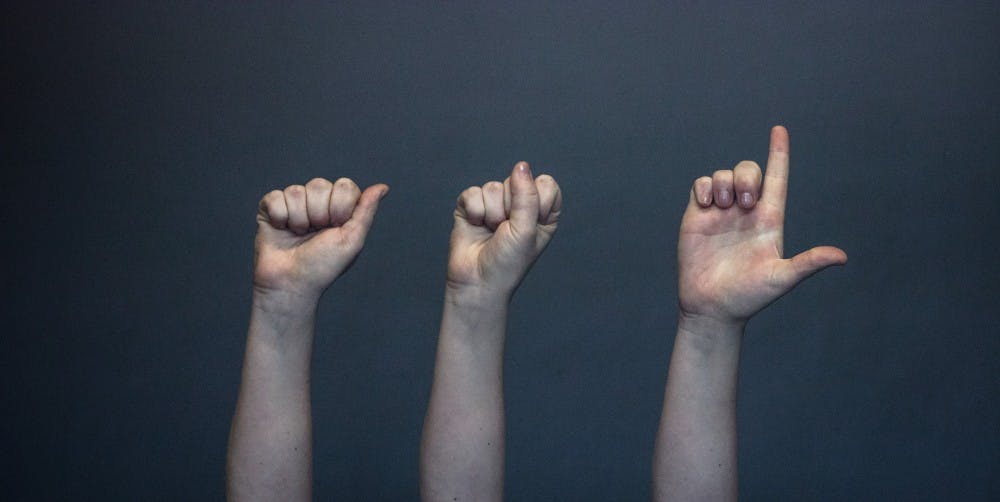Standing on the far side of the stage, someone’s hands move swiftly and decisively to words ringing out from the podium at the center.
Sometimes they’re recognizable, but to most hearing people, they are a blip in peripheral vision, and rarely thought of.
American Sign Language interpreters are doing a hugely important job, particularly when it comes to politics, according to Annie Urasky, Director of the Division on Deaf, DeafBlind and Hard of Hearing at the Michigan Department of Civil Rights.
“Providing interpreters as an accommodation ensures equal access to the information relayed at events,” Urasky, who is deaf, said via email. There was not an interpreter available at the time of the interview.
She went on to say when ASL interpreters are there translating in real time, it allows the deaf and hard of hearing to be full participants in events rather than having to wait for information most others get straight away.
A study from the Journal of Deaf Studies and Deaf Education estimates that 1 in 20 people, or roughly 10 million Americans are deaf or hard of hearing. For scale, that’s greater than the population of New York City by almost two million people.
Of them, about one million people use ASL as their primary language.
ASL interpreter James Cech, who fellow interpreter Stacey Hachey called a “superstar” in the interpreting field, works across Michigan to bridge the gap in communication between the deaf and the hearing.
“Asking somebody’s who’s deaf to wait has some cultural backstory,” Cech said. “Deaf people have been pretty typically told, ‘Oh, we’ll tell you later.’ Historically, they have often not been provided interpreters and have worked hard and struggled for many years fighting for their rights to have interpreters.
“Language access is enough of a reason. But also because what these political leaders do impact their lives. It’s important to know what they’re saying.”
Urasky said one change in the right direction has been a push for more captioned videos on social media.
Captioning is not altogether commonplace outside of the political sphere. It is not guaranteed within it, either.
For example, The State News checked the first ten results on YouTube for President Donald Trump’s inaugural speech. Only one was open-captioned, though it did not include the entirety of the address.
Most videos, including those from major outlets such as C-SPAN, The Wall Street Journal and ABC, were not captioned at all.
The State News could not find video of an ASL interpreter working at the event.
“American democracy is based on an informed and engaged citizenry. Without access to events, full participation can be difficult, if not impossible for some,” Urasky said. “That fundamentally undermines the basic tenets of American democracy.”
Accessibility, she said, can often be an afterthought.
At another inauguration, however, it was a different story.
Hachey, taking turns with a fellow interpreter, was on stage during the entire 2019 inauguration ceremony in Lansing, Michigan. She interpreted in Detroit at the Cobo Center celebration later that day as well.
“The big events like the inauguration do tend to be covered,” Hachey said.
Support student media!
Please consider donating to The State News and help fund the future of journalism.
She added that Urasky’s division at Michigan Department of Civil Rights is working with the governor’s office for greater accessibility during the upcoming State of the State address on Feb. 12.
“They’re trying to get that so it’s actually interpreted on the television instead of having that community trying to read the captions, they’re trying to get it so that the interpreter will actually be on the screen,” Hachey said.
When reached for comment, Gov. Gretchen Whitmer’s office said there would be an ASL interpreter present at the State of the State address and closed captioning will be provided, though they did not specify whether or not the interpreter would be on screen.
Still, having an ASL interpreter at most public political events is not commonplace.
“It should be best practice for ASL interpreters to be available at all events open to the public. But that is a difficult thing to ensure for all levels of government,” Urasky said.
Currently, Michigan law states that an ASL interpreter is only required at public events if they are prior-requested.
“It always makes a big difference to the deaf community who uses ASL when they know that an interpreter is going to be provided, because typically they’re not,” Hachey said. “It’s not the first thing that’s thought of.”
The deaf community being an afterthought at public events like political rallies, inaugurations or on television came up in conversations with Urasky, Hachey and Cech. Despite progress being made in accessibility the past few years with the 2007 Deaf Persons Interpreter Act, much of the world is walled off from them.
“Too often, accessibility for the deaf, deaf-blind and hard of hearing communities is seen as a burden,” Urasky said. “Individuals who are deaf, deaf-blind and hard of hearing live in a society that is largely inaccessible to them.
“They should not be limited in their ability to fully engage and participate as citizens, and their ability to not hear should not be a barrier to accessing services, engaging in educational opportunities, or otherwise experiencing what the world has to offer.”
Cech sees his part in making that happen very simply.
“The biggest value of my role in any environment where a deaf person needs to advocate for themselves is that they can just do it,” Cech said. “They can just be them, and I’m there.”
Discussion
Share and discuss “ASL interpreters bridge language gap for deaf, hard of hearing” on social media.






